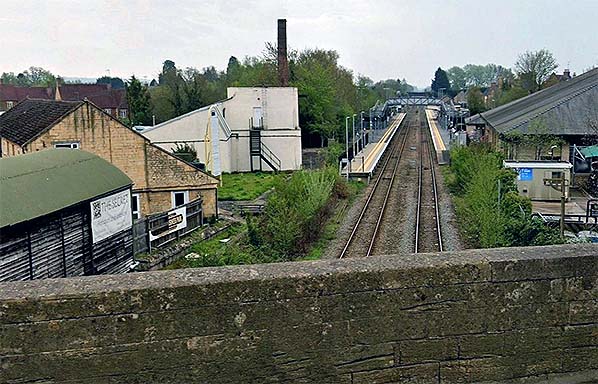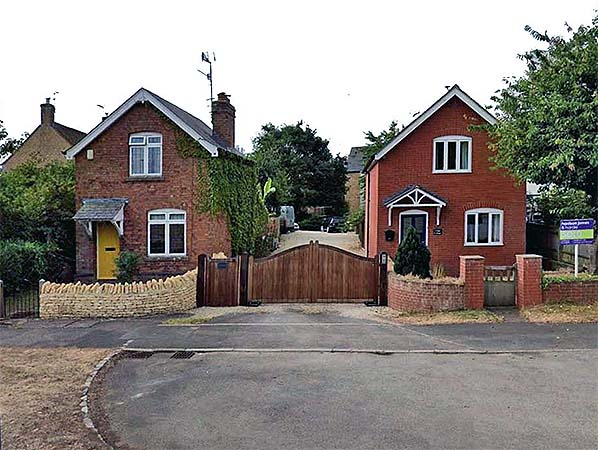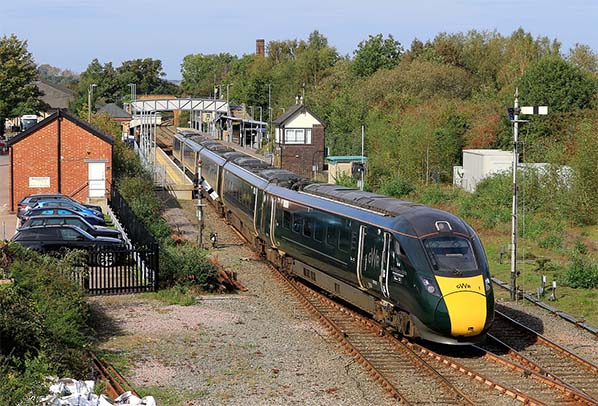
[Source: Darren Kitson]
Moreton-in-Marsh Station: Gallery 6
April 2013 - July 1922 25.jpg) Moreton-in-Marsh station forecourt in April 2013. Externally little has changed since the 1950s apart from the removal of the entrance porch below the canopy.
Photo by Alan Young marsh1.jpg) Looking south from the Up platform in June 2016. The Shipston branch side of the island platform is behind the waiting shelter.
Photo by Nick Catford marsh3.jpg)
Shipston-on-Stour side of the island platform at Moreton-in-Marsh looking south from the island platform in June 2016. The track and sidings have been lifted. Behind the photographer the line curved away to the north-east towards Shipston-on-Stour.
Photo
by Nick Catford
marsh2.jpg) The new footbridge at Morton-in-Marsh in June.2016. The bridge gives a good view of the trackless Shipston branch platform.
Photo by Nick Catford
marsh6.jpg) A number of replica totem signs have been fitted at Moreton-in-Marsh in recent years. These were paid for by former Moreton resident and railway enthusiast Christopher Horne.
Photo by Nick Catford marsh9.jpg)
The 1883 GWR signal box at Moreton-in-Marsh. The signal box at the south end of the island platform is an unusual survivor and still in use. When Network Rail re-doubled two sections of the Cotswold Line between Oxford and Worcester in 2011 there was not enough money to re-signal the two re-doubled stretches of line which included the 16-mile stretch between Moreton-in-Marsh and Evesham. Semaphore signals were retained at Moreton-in-Marsh and a new semaphore was added at the south end of the down platform. This was in order to allow terminating trains from London to return without the need to cross to the up line and reverse back into platform two.
Photo by Nick Catford marsh7.jpg) Looking south from the end of the Moreton-in-Marsh Down platform in June 2016
Photo by Nick Catford marsh10.jpg) Looking north along the Shipston-on-Stour platform at Moreton-in-Marsh in June 2016. The Shipston-on-Stour line curved away to the right beyond the platform.
Photo by Nick Catford 
Facing south from Todenham Road, Moreton-in-Marsh in July 2022. The road layout has changed here since railway days and the original road ran left to right in front of the cottages. The cottage on the left is the original crossing keeper's cottage erected by the GWR and that on the right is a modern build obviously designed to replicate the style of the original but with some difference. The photographer is standing upon what was the trackbed, the track running through what is now the gap between the two cottages. The level crossing was where the pavement now is in front of the wooden gates. The track, having crossed the road, curved to the right behind the modern cottage and in tramway days continued into Morton Wharf. In railway days it still curved to the right but then immediately curved south again to enter Moreton-in-Marsh station. Behind what are now the wooden gates stood a 'Limit of Shunt' board applicable in the Down (to Shipston) direction. The reason was the Shipston branch not commencing, for operational reasons, until the north side of the level crossing and south of the crossing was actually part of Moreton goods yard. Moreton-in-Marsh station is hidden from view in the right background. To the left of the original cottage had stood an original tramway building, its purpose is unclear. It was demolished circa 1989 and was reputedly the last surviving tramway building from the original tramway at Moreton-in-Marsh. Click here to see a map.
Photo
by Greg Wheeler
 The site of Todenham Road level crossing, Moreton-in-Marsh in July 2022. The road layout here has changed in relatively recent times and the original road ran left to right across the photograph, the photographer here standing bedside the modern stretch of road. The level crossing was roughly where the pavement passes in front of the wooden double gates. The photographer is standing on what was the track bed of the Shipston-on-Stour branch, which having crossed the road curved westwards (to the right) before curving southwards to enter Moreton-in-Marsh station. This level crossing was, in a manner of speaking, the only one on the Shipston-on-Stour branch to be manned after 1929. North of the crossing was the official start of the branch while south thereof was part of the goods yard and once a Shipston bound train had crossed the road it was 'locked in' to the branch by a member of the station staff. Upon the train's return the whistle would be sounded and a station staff member would appear to unlock the gates, locking them again after the train had crossed the road. The cottage on the left is the original GWR structure while that on the right is, fairly obviously, modern but mimics the general style of its neighbour - a quite nice touch but which may have been dictated as much by the size and shape of the plot than to anything else. Until circa 1989, a building thought to have been the last surviving structure connected with the former horse tramway had stood behind and to the left of the GWR cottage. This claim regarding the horse tramway connection is however open to question as the tramway at this point did not follow the same course as the later railway. Instead the tramway passed through roughly where the tree stands on the right before turning sharply west south-west to reach its wharf terminus. When converted to a proper railway, the route, just north of the level crossing, was deviated slightly to the east. Presumably this was done to very slightly ease the curves on the approach to the station.
Photo by Greg Wheeler  On Sunday the 8th of October 2023, the Cotswold Line was closed between Moreton-in-Marsh and Worcester Shrub Hill for engineering work and presumably the detested rail replacement omnibus was provided. Trains from the Oxford direction therefore terminated and reversed at Moreton-in-Marsh. With the 1950s goods shed on the left, Hitachi Class 800 No. 800032 is here seen departing with the 13:53 service to Paddington. It had of course arrived at the Down platform and is here using the crossover to gain the Up line. Such movements could once only be controlled by a ground (shunt) signal. The lower quadrant signal on the left is a fairly recent addition which was reputedly made up from parts which happened to be lying around. The low height of the signal is for sighting purposes due to the close proximity of drivers of southbound trains in the Down platform. The rather unpleasant Class 800 is a bi-mode train capable of operating off OLE (overhead electric) or diesel-electric. They came about as a result of the disastrous and ultimately curtailed Great Western electrification scheme which at the time of writing has not even made it as far as Oxford, while trains for the West Country among other places, run part way on OLE and part way on diesel power and the transition can be undertaken on the move. Whether the electrification scheme is ever completed as originally intended remained to be seen at the time of writing.
Photo by Martin Loader from his Hondawanderer web site
|

marsh5.jpg) The Shipston-on-Stour platform looking south in June 2016.
The Shipston-on-Stour platform looking south in June 2016.marsh8.jpg)
marsh11.jpg)

 Home Page
Home Page